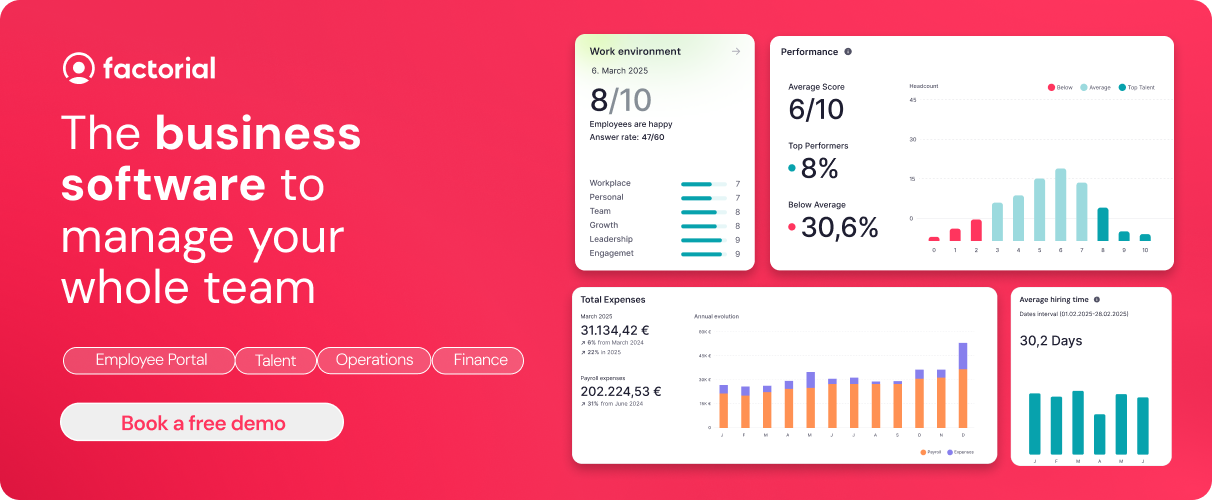We’re willing to bet that your ultimate aim as a business is to be as successful as possible, right? Of course, it is. But the only realistic way to achieve this is by making sure that your employees deliver quality work that meets or exceeds expectations. Sounds simple enough in theory, but in reality, this can be quite a challenge unless you find a way to clearly communicate what these expectations are. Here’s a solution for you: performance goals at work. With the right benchmarks, you can challenge your employees to reach their full potential and contribute to the success of your organization.
With this in mind, today we are going to share 24 examples of performance goals at work, specifically focused on objectives aimed at improving soft skills, accountability, professional growth, collaboration, and problem-solving.
A complete performance management toolkit in a single platform ✅
What Are Performance Goals at Work?
Performance goals at work are a key employee performance management strategy. Breaking it down to its bare bones, they are clear and specific benchmarks for measuring and guiding employee progress and development. Examples of performance goals at work include enhancing communication skills, meeting project deadlines, improving conflict resolution skills, and developing collaborative skills.
Essentially, with this strategy, you meet with an employee, discuss their current performance, identify areas for improvement, and set specific, measurable performance goals that align with both their personal development and the company’s strategic objectives. This collaborative approach ensures that the employee understands their role and is motivated to actively contribute to the company’s success. Over time, these goals should become increasingly challenging to help nudge employees along the path of continuous development.
The ultimate aim here is to create a high-performance culture where employees consistently meet or exceed the requirements of their roles. By framing your performance expectations as tangible goals, each employee understands which areas of their development they need to work on before the end of the performance review phase. Remember to align employee performance goals with team objectives, individual interests, and opportunities for personal growth.
Why Are Performance Goals at Work So Important?
So, what are the benefits of setting performance goals at work? Do they work? Is it worth the effort?
To be effective, you need to set clear, strategic, and relevant goals. Also, provide your employees with the right learning and development tools. This will help them upskill, develop leadership skills, and achieve their objectives.
Here are some of the specific benefits of setting performance goals at work:
- Clarity and direction. They are a platform for you to communicate clear performance expectations to your employees and guide their development.
- Motivation and engagement. Performance goals give employees something tangible to work on. This can be a great engagement and motivation tool.
- Performance tracking. Communicating clear goals makes it easier for you to track and measure employee performance. They also make it easier to detect potential performance gaps that employees need to address through training or performance coaching.
- Skill development. They encourage employees to develop their skills and embrace a culture of continuous professional growth.
- Organizational alignment. A clear strategy for setting performance goals at work helps you align the entire team with the overall objectives of the company.
- Accountability. By making employees responsible for achieving specific goals within a defined timeframe, performance goals at work can be a great tool for encouraging employees to take accountability for their own productivity.
- Employee recognition and rewards: Performance goals are a key part of a pay-for-performance model, where you recognize and reward employees for their achievements. This initiative boosts morale and encourages sustained high performance.
- Productivity and efficiency. Finally, performance goals at work enhance overall productivity and efficiency within the organization.
Methodologies for Setting Performance Goals at Work
OK, great! All clear so far? We’ve seen what they are and why they are so important, but how do you set them?
There are actually a few methodologies that you can use for setting performance goals at work. It’s always best to use an established method as a guide as following a structured approach makes it far more likely that the goals you set will be achievable and achieved.
The most common goal-setting methodologies are:
- SMART Goals
- OKRs
- Locke and Latham’s 5 Principles
- Goal Pyramid
Each of these approaches will help you create clear, aligned and actionable performance goals at work. The best approach for you will depend on your specific organizational needs, company culture, and the nature of the goals you want to achieve. If you’re feeling brave, you could even mix things up and pick a few methodologies for different teams or projects to find what works best for your organization.
First things first, though. Let’s explore these 5 methodologies in a bit more detail.
SMART Goals
SMART is an acronym for Specific, Measurable, Achievable, Relevant, and Time-bound. Although this concept can be applied to any walk of life, in the context of HR, the SMART goals framework provides a structured approach to goal setting, making it easier to create goals that are clear, actionable, and aligned with the overall organizational strategy.
The biggest benefit of creating SMART performance goals is that employees have clarity and a clear roadmap for success. They understand exactly what is expected of them, how you will measure their progress, and the timeframe within which they need to achieve their goals. This clarity helps to eliminate confusion, increase focus, and enhance motivation, ultimately leading to improved performance and greater alignment with the company’s objectives.
For instance, an example of a performance goal at work created using this methodology might be:
Increase customer satisfaction scores by 10% within the next six months by implementing a new feedback system and conducting monthly training sessions for the customer support team.
Objectives and Key Results (OKRs)
OKR stands for Objectives and Key Results, a goal-setting framework used to define and track objectives and their outcomes. With this methodology, you establish two core components: objectives (what you want to achieve) and key results (how you will measure progress towards achieving objectives).
The OKR approach, made popular by companies like Intel and Google and now used by many modern businesses, can be a great tool for aligning individual, team, and organizational goals. By setting clear objectives and measurable key results, employees can focus on what truly matters and ensure their efforts contribute to the company’s success.
For instance, an example of a performance goal at work created using this methodology might be:
Complete advanced sales training and apply new techniques to improve conversion rates by 15%.
Locke and Latham’s 5 Principles
Locke and Latham’s 5 Principles are part of the Goal-Setting Theory developed by Edwin Locke and Gary Latham. This theory emphasizes the importance of setting clear, challenging, and attainable goals to enhance employee performance and motivation.
Specifically, the 5 principles introduced by the theory are:
- Clarity: Set clear, specific goals to avoid ambiguity.
- Challenge: Make sure goals are challenging but still attainable.
- Commitment: Make sure employees commit to the goals. (Commitment is crucial)
- Feedback: Provide employees with regular feedback on their progress so they can make adjustments where necessary.
- Task complexity: Adjust goals according to task complexity so that they are manageable.
For instance, an example of a performance goal at work created using this methodology might be:
Goal: Improve project management skills.
- Clarity. Complete a project management certification course.
- Challenge. Achieve certification within six months.
- Commitment. Dedicate at least five hours per week to study and coursework.
- Feedback. Meet with a mentor bi-weekly to review progress and address challenges.
- Task complexity. Break down the certification course into weekly modules to manage workload effectively.
Goal Pyramid
Finally, the Goal Pyramid methodology is a hierarchical framework for setting and organizing performance goals at work. Strategic goals are placed at the top of the pyramid, and individual operational goals are placed at the bottom. In between, you will usually find levels including tactical goals and departmental goals. This structure increases the chances that high-level strategic objectives align with day-to-day operational tasks.
Advantages of using this methodology include improved clarity, better resource allocation, and enhanced coordination across departments. By aligning goals at every level, employees can see how their individual contributions support the overall mission and objectives of the organization, fostering a sense of purpose and direction.
For instance, an example of a performance goal at work created using this methodology might be:
Strategic goal: Expand market share by 15% in the next fiscal year.
- Tactical goal. Launch three new product lines in the next six months to attract new customer segments.
- Departmental goal. Increase marketing efforts by 25% to promote new product lines and generate leads.
- Operational goal. Each sales team member to achieve a 10% increase in monthly sales targets by the end of the quarter through targeted campaigns and client outreach.
- Individual performance goal: Attend advanced sales training and apply new techniques to improve personal sales conversion rates by 20% within the next quarter.
Discover Business Management Software that helps your team do more. ✅

Examples of Performance Goals at Work
Now we’re getting to the heart of things: specific examples of performance goals at work. This is where we will see all the theories we’ve just covered put into practice. In other words, the sort of goals you should be setting in line with your underlying objective.
Keep in mind that there are various categories of performance goals relating to different aspects of employee development.
Common areas that managers work on when they implement measures to improve performance include:
- Soft skills
- Accountability
- Professional growth
- Collaboration
- Problem-solving
Whichever goals you set for your employees, make sure they are clear, specific and tailored to both the employee in question’s professional development and the company’s strategic objectives. It’s also important to use performance management software to track and measure progress once you have set each employee’s goals.
Without further ado, let’s get to it!
Here are 20 examples of performance goals at work to inspire you (adding to the 4 we gave you in the previous section). We’ve split these examples into different performance categories to help you understand how you can address each area of development through targeted goal setting.
Soft Skills Performance Goals
Soft skills are personal traits or attributes that enhance an employee’s job performance as well as their personal and professional growth. While hard skills are technical and industry-specific, soft skills can be applied to all sorts of jobs and positions. These skills are more about the character and values of an employee rather than what they know. Examples of soft skills in the workplace include critical thinking, communication, motivation, conflict management and time management.
Here are 4 examples of performance goals at work that aim to improve an employee’s soft skills:
- Improve active listening skills by summarizing key points in meetings and asking for feedback.
- Enhance conflict resolution abilities by mediating at least two workplace disputes.
- Develop better time management skills by meeting all deadlines for a quarter.
- Strengthen public speaking skills by presenting in at least two team meetings per month.
Accountability Performance Goals
Employee accountability is when employees take responsibility for their actions, decisions, and performance. When an employee is accountable, they take ownership of their work, fulfil their duties, meet expectations, and understand the impact of their actions on organizational goals.
It’s important to encourage employee accountability because it helps you foster a culture of trust, reliability, and productivity. When employees are accountable, they turn up on time, meet their deadlines, and continuously strive to achieve their goals.
Here are 4 examples of performance goals at work that aim to improve an employee’s sense of accountability:
- Complete all assigned tasks by the agreed deadlines with no need for reminders.
- Regularly update project management tools to reflect the current status of all tasks and projects.
- Own up to and document any mistakes within 24 hours, along with a plan to address and prevent them in the future.
- Attend all scheduled meetings on time and fully prepared, contributing constructively to discussions.
Professional Growth Performance Goals
Professional growth refers to the ongoing process of developing skills, knowledge, and abilities to enhance your career and achieve personal goals within a chosen profession. It involves continuous learning, skill development, and adapting to new challenges and opportunities.
Encouraging professional growth in your organization is important because it helps employees stay up to date with industry trends, improves job performance, increases job satisfaction, and fosters a culture of innovation and excellence. It also helps you build a skilled and adaptable workforce.
Here are 4 examples of performance goals at work that aim to improve an employee’s professional development:
- Complete a relevant certification or professional course within the next six months.
- Attend at least three industry conferences or workshops within the year to stay updated with the latest trends.
- Seek and participate in a mentorship program, either as a mentor or mentee, for ongoing development.
- Read and summarize one professional development book per quarter, sharing key insights with the team.
Collaboration Performance Goals
Collaboration skills are about working well with others and achieving a common goal. It’s more than just finishing a project with a group of people, though. It also means building relationships with a team, resolving conflicts, and creating a work environment where everyone feels included and respected.
Collaboration skills include:
- Communication
- Open-mindedness
- Conflict resolution
- Active listening
- Emotional intelligence
- Delegation
- Understanding a variety of perspectives
- Managing priorities
- Meeting expectations
- Having a cooperative spirit and mutual respect.
These skills are essential for individual growth and team success and pretty much every role and industry needs them. In fact, according to the National Association of Colleges and Employers, 76% of employers want candidates with collaboration skills.
Here are 4 examples of performance goals at work that aim to improve an employee’s collaboration skills:
- Participate in at least one cross-functional team project each quarter to enhance interdepartmental collaboration.
- Schedule and lead monthly team-building activities to strengthen team relationships and communication.
- Provide constructive feedback to team members during project reviews, focusing on enhancing collective performance.
- Facilitate regular team meetings to ensure alignment on goals, progress, and challenges, fostering a collaborative work environment.
Problem-Solving Performance Goals
Finally, problem-solving skills refer to an employee’s ability to identify an issue, analyze the context, and present and implement solutions that resolve it. Strong problem-solving skills empower employees to navigate challenges and contribute to organizational success. The more your employees are able to address and resolve challenges that crop up during their workday, the more productive they will be and the smoother your operations will run. Plus, effective problem-solving can lead to innovative solutions and improvements, driving continuous growth and giving you a competitive edge.
Here are 4 examples of performance goals at work that aim to improve an employee’s problem-solving skills:
- Identify and propose solutions for at least two process inefficiencies within the next quarter.
- Develop a step-by-step problem-solving guide to be used by the team for common issues.
- Lead a team brainstorming session to generate creative solutions for a current project challenge.
- Analyze and resolve a recurring problem within the department, reducing its impact by at least 50% within six months.
How Factorial Can Enhance Performance Management
Regardless of the type of performance goals at work that you assign to your employees, the best way to manage goal progress is to use a performance management system like Factorial to streamline the process, create a supportive and transparent environment, and boost employee morale.
In fact, Factorial’s solution can support you at each step of the performance management cycle.
Specifically, with our performance management software, you can:
- Access comprehensive tools for setting performance goals at work, offering continuous feedback, and managing performance reviews.
- Design employee development strategies in line with the objectives of your company.
- Streamline the performance management process with automated and centralized performance review periods.
- Track employee performance over time, making it easier to identify trends and areas needing your attention.
- Monitor employee performance metrics in real time, so you can make timely interventions and adjustments.
- Generate comprehensive performance progress reports so that you can make informed decisions based on comprehensive data analysis.
- Create tailored learning and development programs for each employee to help them hit their performance goals at work.
- Set reminders for feedback, performance reviews, and goal-setting deadlines.
Not only that, but by integrating Factorial’s performance management software, you can enhance every aspect of the employee journey, helping you create a supportive, transparent, and productive work environment. Think about how easy it will be to track individual and team performance, provide positive feedback, and review performance metrics.
Still not convinced? Fancy a little taster of what we have to offer? Then download our free employee journey map template and use it to assess the employee experience during each step of the employee journey and measure the impact of your performance management strategy on your employees. This makes it much easier to plan for improvement and help every member of your organization hit their performance goals at work!



